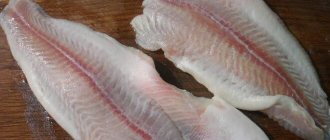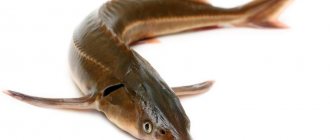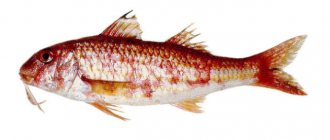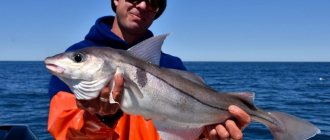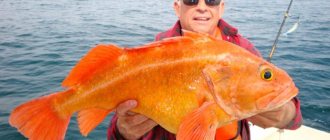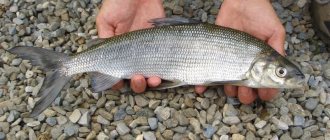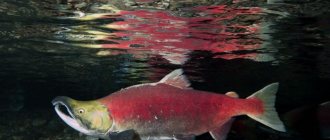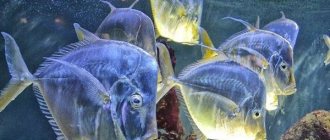What are the benefits of haddock?
- General . It has many useful properties. For example, it is actively involved in protein production, strengthens bones and teeth and improves immunity. In addition, haddock is a preventative against cancer. It also strengthens the circulatory system, improves vision and accelerates the healing process of skin wounds. Regular consumption of haddock improves the functioning of the nervous system and heart.
- For women . Haddock protein is very easily absorbed by the human body, so haddock fillet is perfect for dietary nutrition. In addition, this fish helps improve metabolism and slows down the aging process in the body. It is known that many women face a lack of hemoglobin - haddock helps to cope with this problem. During pregnancy, fish will saturate the body with vitamins and minerals, which are necessary during this difficult period for both the expectant mother and the unborn child. And during lactation it will be an excellent source of iodine for the child.
- For men . For the stronger sex, haddock will also not be useless. Statistics show that men are more likely to suffer from heart disease, so eating fish will help control blood cholesterol levels and improve blood circulation. In addition, this fish contains very little fat and a lot of protein, which will appeal to athletes.
- For children . Fish can be included in a child’s diet only after he reaches the age of three and only after consultation with a pediatrician, who will prescribe the dose. Haddock will help in bone development and strengthen children's immunity. Doctors recommend giving your child fish oil in tablet form. With regular consumption of this fish, the need for fish oil will disappear.
- When losing weight . Haddock is low-calorie, low-fat, but at the same time it contains a lot of protein, which allows it to be used in the diet of people losing weight. As a dietary product, it reduces cholesterol in the blood and strengthens the cardiovascular system. Fish should only be used as part of some kind of diet, since it alone cannot provide the body with everything it needs to exist.
Secrets of cooking
Many housewives believe that pollock has a rather bland taste and is a little dry. For this reason, it is not in such demand in stores and supermarkets as pink salmon or salmon. Indeed, if you simply fry it in oil, like any river fish, it will be very dry and practically inedible. The best way to prepare this variety is to simmer over low heat in a deep bowl, adding a sauce made from flour and white wine. During the stewing process, sautéed onions and roots (carrots, parsley, finely chopped celery root) are also added. Here are some more ways to prepare sea fish:
- Cutlets made from pollock fillet, minced through a meat grinder. To make them fluffy, you need to add a beaten egg or one grated potato;
- Pollock soup. To make the broth rich and fatty, you can add other varieties to the fish soup, for example, salmon or pink salmon;
- Yeast dough pie filled with mashed potatoes and fish fillet;
- Fish zrazy with mushrooms.
Canned pollock
Sometimes canned pollock ends up on supermarket shelves. The best of them are considered to be those prepared directly on the ship, immediately after catching the fish. As a rule, they are made in Murmansk or Norway. Here are the main types of such canned food:
- Pollock in oil or in its own juice;
- Pollock with canned vegetables;
- Pollock liver;
- Caviar.
The caviar of this fish has a delicate, slightly salty taste; it goes well with sandwiches made from black bread with butter. Pollock liver is rich in vitamin D and is almost as concentrated as cod liver. It can be added to salads or spread on sandwiches instead of butter. Fans of home canning can also independently preserve pollock fillets using an autoclave; the shelf life of such products is no more than two years (subject to all storage conditions).
This variety is practically never found in dried or dried form. When choosing canned food, you should carefully study their composition. The ideal option is a jar that says: “saithe, water, black pepper (or other spices)”, without preservatives or other food additives.
Fish selection criteria
When choosing pollock in a supermarket or market, you should first of all pay attention to its smell. It should be fresh, sea-based. A musty smell indicates that the product is no longer fresh, and you should refrain from purchasing it.
When purchasing frozen fillets, it is not recommended to purchase products in opaque packaging. If there are no other options, the packaging needs to be shaken thoroughly. A characteristic noise when shaking indicates that there is a large amount of ice inside. This happens when fish is repeatedly frozen and thawed, as well as in cases where the manufacturer deliberately wants to increase the weight of the product due to ice.
If the fish is slippery, sticky, or unpleasant to the touch, this also indicates poor quality and possible staleness of the product. The scales of high-quality pollock should be shiny, not dull.
“Seafood” is an indispensable product in the diet of a modern person. In order for sea fish to be tasty, you need to prepare it correctly and choose quality products. Pollock is one of its most valuable varieties. It’s a shame that so far not all gourmets have been able to appreciate it. It should occupy an important place in the diet of those who care about their health, along with cod, hake and other inhabitants of the northern seas. Preparing pollock is very easy, the main thing is to make it soft and aromatic, spices and a variety of sauces (both store-bought and homemade) will help with this.
What are the benefits of cod?
- Disease prevention . Cod reduces the risk of developing certain diseases. For example, due to its low fat content, it removes cholesterol from the body and strengthens the heart, which prevents heart attacks, high cholesterol, thrombosis, and leukemia. Eating fish also reduces the risk of strokes, atherosclerosis, pulmonary embolism, cancer and myeloma.
- For the cardiovascular system . It has already been said that eating fish has a beneficial effect on the cardiovascular system. The omega-3 it contains improves heart rate. Studies in people taking fish oil (an omega-3 fatty acid) have shown improvements in heart function after just two weeks.
- Cleansing the body . The phosphorus contained in cod fillets is very important for kidney health. It has a diuretic effect, which is followed by cleansing of the kidneys. Thanks to regular consumption of cod, the water-salt balance in the body is normalized, and accumulated waste and toxins are eliminated.
- For digestion . Since eating cod helps cleanse the body, it helps digestion even more so. Phosphorus plays an important role in improving digestion, while niacin and riboflavin improve metabolism, which is necessary for the human body. Thanks to these three substances, diarrhea, constipation and stomach upsets do not occur. So, in order to have healthy digestion, and the entire body as a whole, you need to eat cod regularly.
- For appearance . Protein plays an important role in proper muscle function, so cod is an essential food for muscle health. But besides muscles, there is something else that is important to many people. For example, the health of their hair, skin and nails. Fish also helps with this, because it contains collagen and a lot of protein, which maintain the health of such important parts of the human body. But in addition to external data, cod also retains its internal content. For example, this applies to bones. Due to the high phosphorus content in fish, bone health is greatly improved.
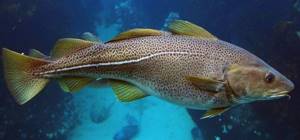
Chemical composition and calorie content
Averaged data on chemical composition and calorie content were taken from the official website of the US Agricultural Research Service.
- water – 83 g;
- proteins – 16 g;
- nitrogen – 2.6 g;
- fats – 0.45 g (cholesterol – 54 mg);
- carbohydrates – 0;
- microelements: Ca – 11 mg, Fe – 0.17 mg, Mg – 21.1 mg, P – 227 mg, K – 286 mg, Na – 213 mg, Zn – 0.32 mg, Cu – 0.021 mg, Mn – 0.011 mg, I – 150 µg, Se – 25.9 µg;
- vitamins: thiamine - 0.02 mg, riboflavin - 0.057 mg, niacin - 3.36 mg, pantothenic acid - 0.403 mg, vitamin B-6 - 0.281 mg, B-12 - 1.83 mcg, A - 17 mcg, E – 0.45 mg, D – 0.5 µg, K – 0.1 µg.
- essential – tryptophan, threonine, isoleucine, leucine, lysine, methionine, cysteine, phenylalanine, tyrosine, valine;
- replaceable - arginine, histidine, alanine, glycine, proline, serine, aspartic and glutamic acids.
Fatty acid content: saturated – 0.091 g, monounsaturated – 0.061 g, polyunsaturated – 0.166 g.
The amount of calories depends on the habitat of the fish. Thus, raw wild haddock has a calorie content of 80-88 kcal/100g, and farmed haddock has a calorie content of 72-73 kcal/100g.
- boiled – 87-93;
- baked without adding oil – 94;
- fried without oil – 142;
- in batter – 195-230.
Contraindications
First of all, contraindications are related to allergies to seafood or individual intolerance to these products. Intolerance is quite rare, but it is always better to educate yourself about your health than to eat something you may be allergic to. Such careless handling of fish can end badly. Both cod and haddock are large predators that can accumulate heavy metals, including mercury. Doctors recommend eating no more than 200 grams of fish per week to avoid possible problems.
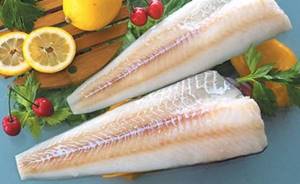
Reproduction of pollock
Spawning near pollock continues from January to July. It takes place in the coastal zone. Most often, spawning is observed in April, when the water temperature is no more than 10 degrees and the salinity is no higher than 35%. The eggs are deposited on soft soil at a depth of about 200 meters.
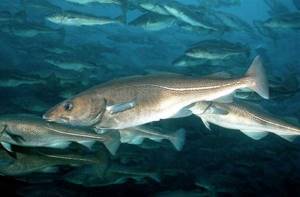
In pursuit of prey, pollock can dive deep or even jump out of the water.
On average, one female produces about 6 million eggs. The eggs develop over 2 weeks. The sea current carries the eggs from the coast of Norway to a great distance, so the pollock ends up far into the North Sea.
At first, the fry prefer to live in bays and not move too far from the shore. And after spawning, adult pollocks make a return migration to the north to their feeding grounds.
Catching
The pollock that we see on store shelves is, naturally, caught industrially. But there are anglers who successfully fish for it using amateur gear:
- a fishing rod for vertical trolling;
- spinning.
Sheer lure
For vertical trolling, special marine spinning rods with increased tests on bait and fishing line are used. Values of the order of 100 or 200 grams are not something prohibitive in this fishing.
And this is not surprising, because rather heavy vertical spoons or jigs are used as bait.
Jigs are heavy vertical driven spoons. Depending on the fishing horizon, they can weigh from ten - for river fishing and up to more than a hundred grams - for sea fishing.
The peculiarity of sea jigs is that the material of the bait body and equipment - hooks and winding rings - must have an anti-corrosion coating that resists chemically active sea salt. Simple river baits will not last long, even if they are thoroughly washed with clean water after fishing.
Fishing with jigs involves alternately raising and lowering the bait in a selected layer of water to a height of 50–80 centimeters. Most often, fishing begins at the bottom and gradually increases the fishing horizon.
Attention! From boats you can fish not only with vertical lures, but also with spinning rods. Here, it is best to use regular oversized spoons as bait.
Spinning
In those places where significant depths begin close to the mainland, coastal fishing for pollock with a spinning rod is possible - this, for example, is possible in the same Norway, in the fjords.
For this, the most powerful coastal spinning rods are used, 10–12 feet long, with tests up to one hundred grams. The action of the blanks is medium or even slow, which allows for better shock absorption of the gear when fishing for a sea trophy.
Reels are used inertia-free, Shimano sizes 4000–6000, or barrel-type multipliers. It is desirable that their mechanisms are protected from sea water.
The following are used as baits:
- heavy deep wobblers;
- oscillating spoons;
- jigs.

